Post-Fire Recovery & Resources: Complete Guide
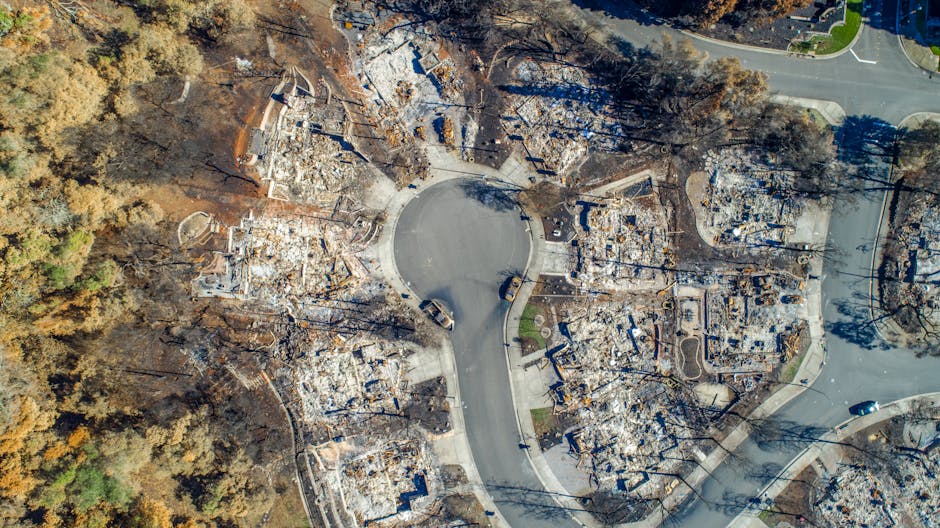
Navigating the Path to Recovery After a Fire
Post-Fire Recovery & Resources are critical steps to rebuilding your life after experiencing a devastating fire. Here’s what you need to know immediately:
- Safety First: Wait for official clearance before returning to your property
- Document Everything: Take photos/videos of all damage before cleanup
- Contact Insurance: Notify your provider within 24 hours
- Find Temporary Housing: Use Red Cross, insurance ALE, or family support
- Apply for Assistance: FEMA, SBA loans, and local programs offer financial help
The aftermath of a fire can feel overwhelming. One moment you’re living your normal life; the next, you’re watching flames consume your home and wondering where to turn. Post-Fire Recovery & Resources encompass a structured approach to rebuilding—from immediate safety concerns to long-term rehabilitation of your property and emotional wellbeing.
Recovery doesn’t happen overnight. It’s a process that requires patience, persistence, and knowing which resources to access at each stage. Whether dealing with insurance claims, seeking government assistance, or deciding whether to rebuild or sell, having a clear roadmap can make all the difference during this challenging time.
I’m Daniel Cabrera, a real estate expert with over 15 years of experience helping homeowners steer Post-Fire Recovery & Resources, having personally assisted hundreds of families in finding solutions after fire damage to their properties.
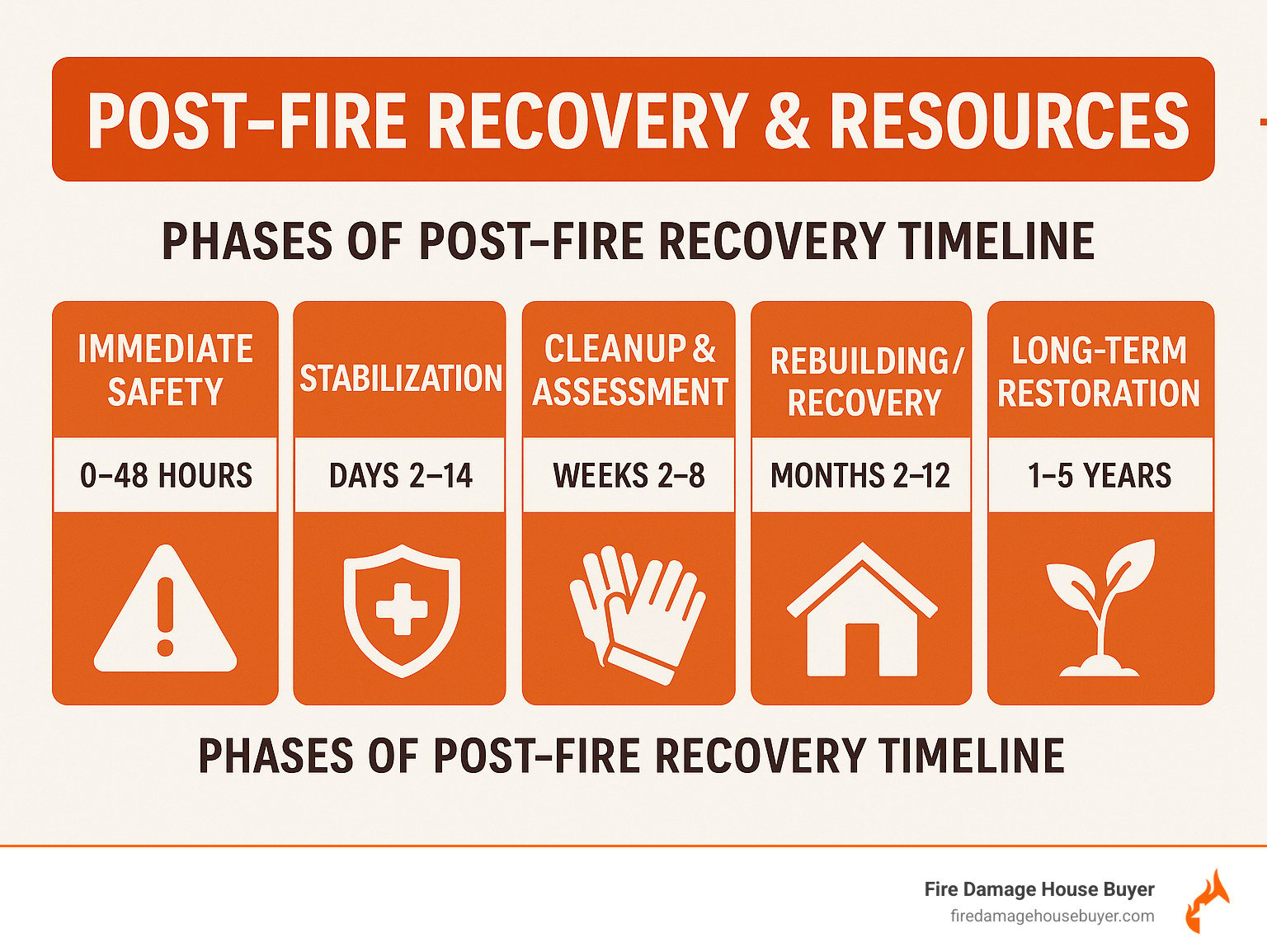
Immediate Safety & the First 24 Hours
Those first 24 hours after a fire can feel like the longest day of your life. The American Red Cross has seen it time and again – what you do during this critical window can make all the difference in keeping your family safe and starting your recovery journey on the right foot.
Sarah Martinez, who’s helped countless families as a disaster response coordinator with the Red Cross, puts it this way: “The piercing sound of smoke alarms and the acrid smell of smoke marks the beginning of a nightmare no homeowner ever expects to face. But what you do in those first hours can make all the difference in your recovery journey.”
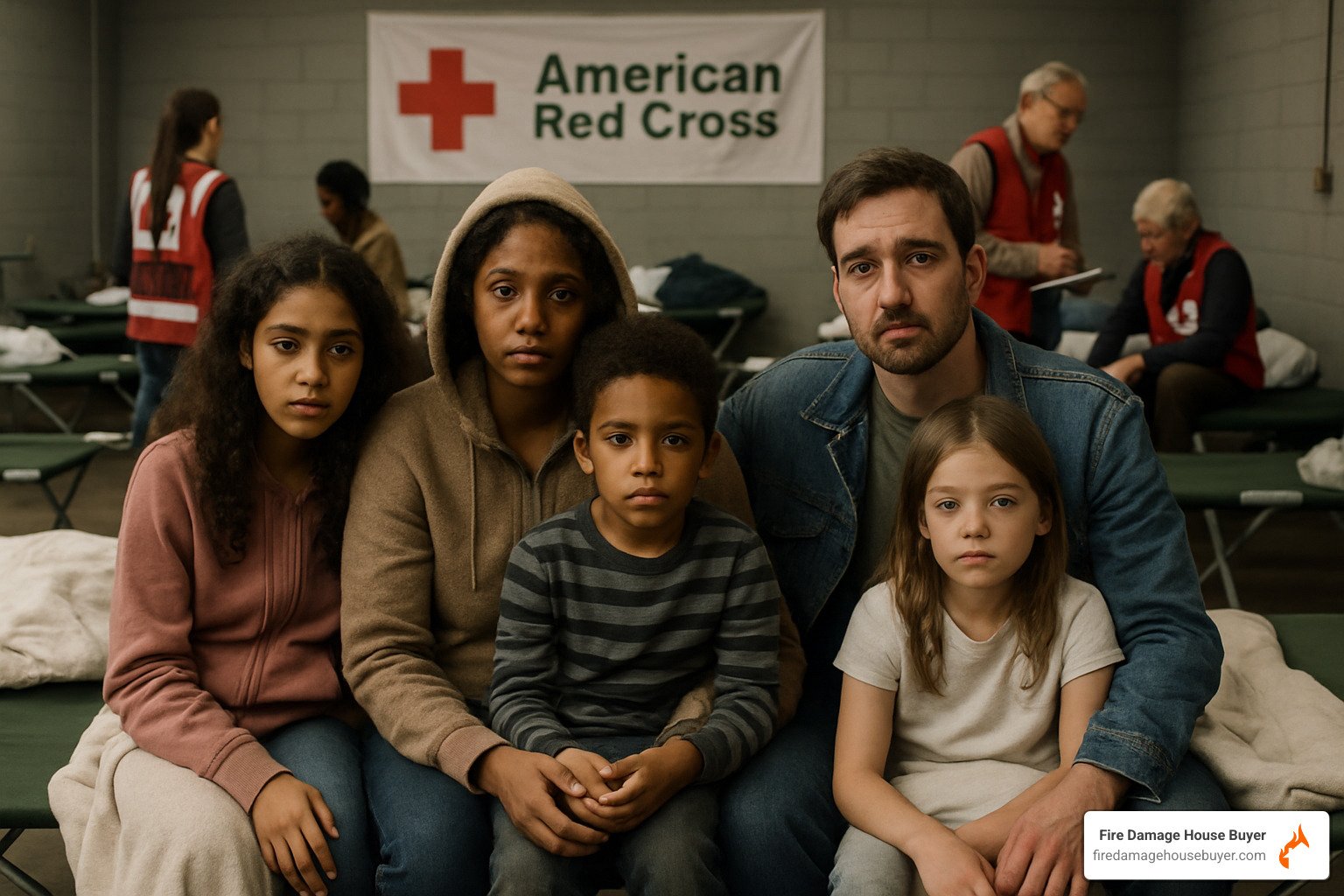
First things first – don’t rush back to your property until fire officials give you the all-clear. It’s hard to stay away, I know, but your safety matters more than anything. If you’ve been evacuated, head to an emergency shelter set up by the Red Cross or Salvation Army. These havens provide much more than just a roof – you’ll find temporary housing, hot meals, first aid for minor injuries, compassionate crisis counseling, and information about assistance programs all in one place.
If you or a loved one has suffered burns, remember this simple first aid rule: cool and cover. Run cool (not cold) water over burns for 3-5 minutes, then gently cover with a clean, dry cloth. Please don’t reach for butter, toothpaste, or other home remedies – they can actually make things worse. For anything beyond a minor burn, seek medical help right away.
Stabilize People, Then Property
Your first priority is taking care of your family’s basic needs – everything else can wait.
Start with medical checks for everyone, even if nobody seems hurt. Smoke inhalation symptoms can be sneaky, sometimes not showing up until hours later. Better safe than sorry.
Take a moment to notify loved ones that you’re safe. A quick text message or social media update can prevent a lot of worry among your extended family and friends who might have heard about the fire.
Next, secure temporary housing. If staying with family or friends isn’t an option, call your insurance company right away about your Additional Living Expenses (ALE) coverage. This valuable coverage typically handles hotel costs, meals, laundry expenses, pet boarding if needed, and even transportation costs while you’re displaced.
“Most people don’t realize that ALE funds can often be advanced within 48-72 hours,” explains insurance adjuster Michael Torres. “You don’t have to wait for your entire claim to be processed to access these emergency funds.”
Don’t forget about your furry family members! Animals can suffer from smoke inhalation too. If you evacuated with pets, a quick vet check can spot problems you might miss.
Document Everything Before Cleanup
As overwhelming as it feels, resist the urge to start cleaning up right away. Documentation comes first in the Post-Fire Recovery & Resources process.
Before touching anything, grab your phone and take comprehensive photos and videos of every room from multiple angles. Create a detailed inventory of damaged items – brand names, purchase dates, and estimated values if you remember them. Save all receipts for emergency purchases you make in these first days.
I also recommend keeping a notebook where you record conversations with officials and insurance representatives – dates, names, and what was discussed. Your memory will be overloaded during this stressful time, and these notes will be invaluable later.
“I’ve seen countless cases where homeowners lost thousands in potential insurance compensation simply because they cleaned up before properly documenting the damage,” says fire restoration specialist Jennifer Wu.
Create a simple system for organizing all this information – maybe a dedicated folder on your phone for photos, and a physical folder for paper receipts and notes. Keep digital backups too, if possible. This documentation will be your best friend when filing insurance claims or applying for assistance programs.
Want more guidance on handling insurance claims? Our Fire Damage Insurance Claims Guide walks you through the entire process step by step.
Is It Safe to Go Home? Structural, Environmental & Health Hazards
After a fire, your home may look okay from the outside, but danger often hides where you can’t see it. The U.S. Fire Administration is crystal clear on this: don’t go back until officials give you the green light.
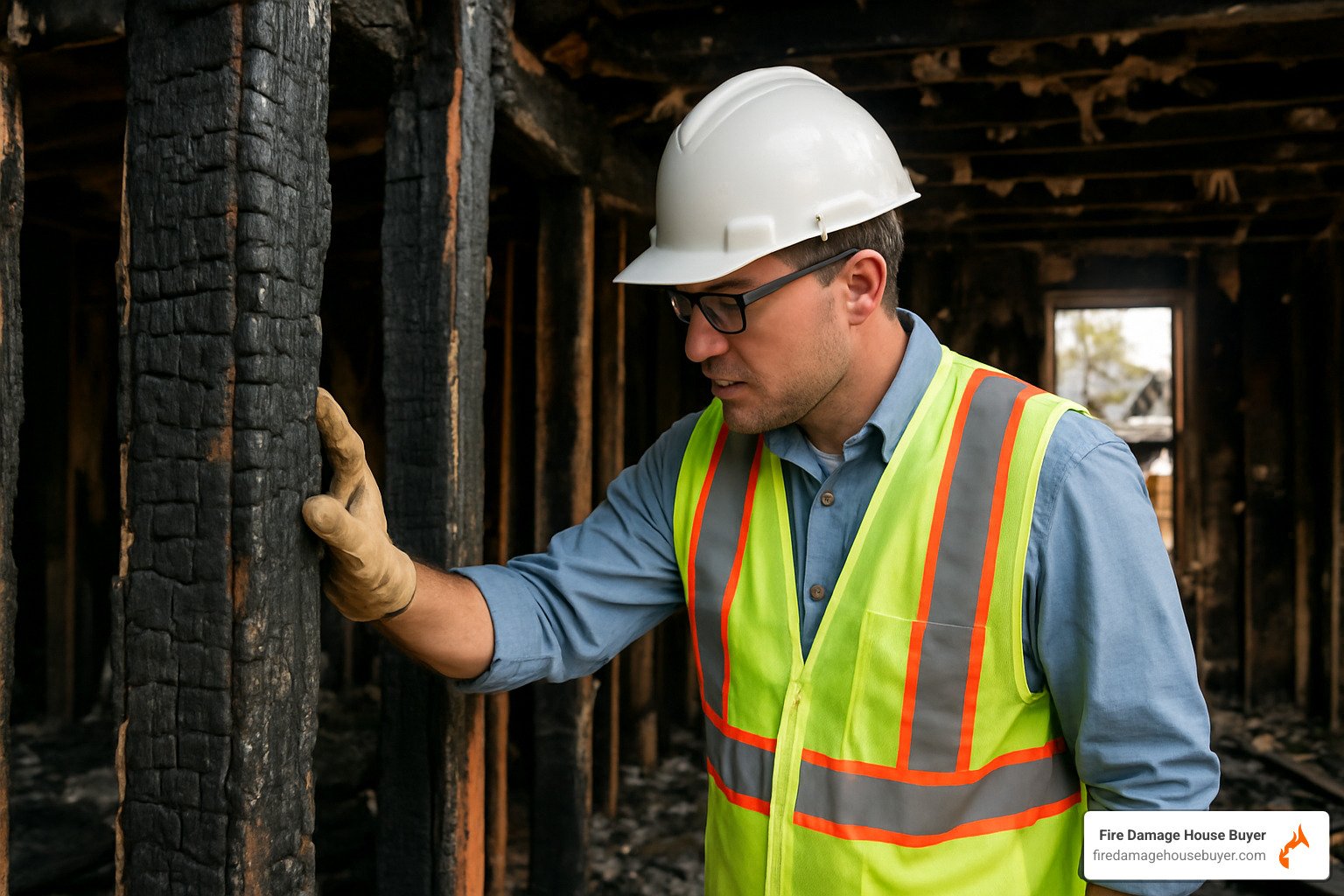
“Even small fires can weaken your home in ways you’d never expect,” says structural engineer Robert Chen. “I’ve walked into homes where ceilings came crashing down days after a fire because the heat had secretly damaged the joists, even though they looked perfectly fine.”
When authorities finally say it’s safe to return, you’ll likely need some professional help before you can truly call it “home” again:
Structural engineers can tell you if your walls, foundation, and roof can still do their jobs. Air quality specialists will check for invisible particles that could harm your lungs. Electricians need to inspect your wiring before you flip any switches, and plumbers should verify your water system wasn’t damaged by extreme heat.
Beyond your four walls, the environment around your home might have transformed into something more dangerous:
The risk of flash flooding skyrockets after wildfires. Without vegetation to soak up rain, water runs off faster. Even stranger, fire can actually make soil repel water instead of absorbing it, creating a perfect recipe for floods where they never happened before.
Toxic ash isn’t just dirty—it’s dangerous. What looks like simple dust might contain heavy metals, asbestos from older buildings, or chemical residues from your household items that burned. This isn’t something you want to breathe or touch without protection.
Trees and branches that survived the flames might still be fatally weakened. A gentle breeze a week later could bring them crashing down when you least expect it.
Post-Fire Recovery & Resources: Hazard Checklist
Before stepping foot on your property, run through this mental checklist of potential dangers:
| Hazard | Visual Signs | Professional Assessment Needed |
|---|---|---|
| Structural damage | Sagging roofs, leaning walls, cracked foundation | Structural engineer inspection |
| Electrical hazards | Melted wiring, damaged panels, water near electrical systems | Licensed electrician evaluation |
| Gas leaks | Smell of gas, hissing sounds, dead vegetation | Utility company inspection |
| Water contamination | Discolored water, unusual odor, damaged pipes | Water quality testing |
| Toxic materials | Visible asbestos, lead paint, chemical containers | Environmental testing |
| Unstable trees | Charred trunks, leaning trees, exposed roots | Arborist assessment |
Former firefighter and safety consultant James Rodriguez puts it bluntly: “The most dangerous hazard is the one you don’t see coming. I’ve helped people who were hurt days after a fire by structures they thought were safe suddenly giving way.”
Post-Fire Recovery & Resources: Return-Home Toolkit
When it’s finally time to assess your property, don’t walk in empty-handed. Gather these safety essentials first:
An N95 respirator mask is non-negotiable—regular dust masks won’t cut it for toxic particles. Protect your hands with heavy-duty work gloves and your feet with sturdy boots that can handle nails and debris. A hard hat might seem excessive until something falls from above.
Bring a flashlight with extra batteries since power may be unreliable. Keep a first aid kit within reach for minor injuries. Hand sanitizer and disinfectant wipes help manage contamination, while a HEPA vacuum can safely capture dangerous fine particles during initial cleanup.
Don’t forget plastic sheeting and duct tape for making temporary repairs to protect your home from the elements.
“Proper protective equipment isn’t just a good idea—it’s essential,” says industrial hygienist Dr. Lisa Chen. “Those tiny soot particles can travel deep into your lungs and cause problems that might not show up for years.”
For more comprehensive guidance on navigating these hazards safely, visit our Fire Damage Resources page where we’ve compiled expert advice specifically for homeowners in your situation.
Government Programs, Insurance & Financial Lifelines
Recovering financially from a fire can feel like piecing together a complex puzzle. The good news? There are plenty of pieces available to help you rebuild your life. In 2022 alone, wildfires scorched over 7.6 million acres across the United States, leaving thousands of families wondering, “What now?”
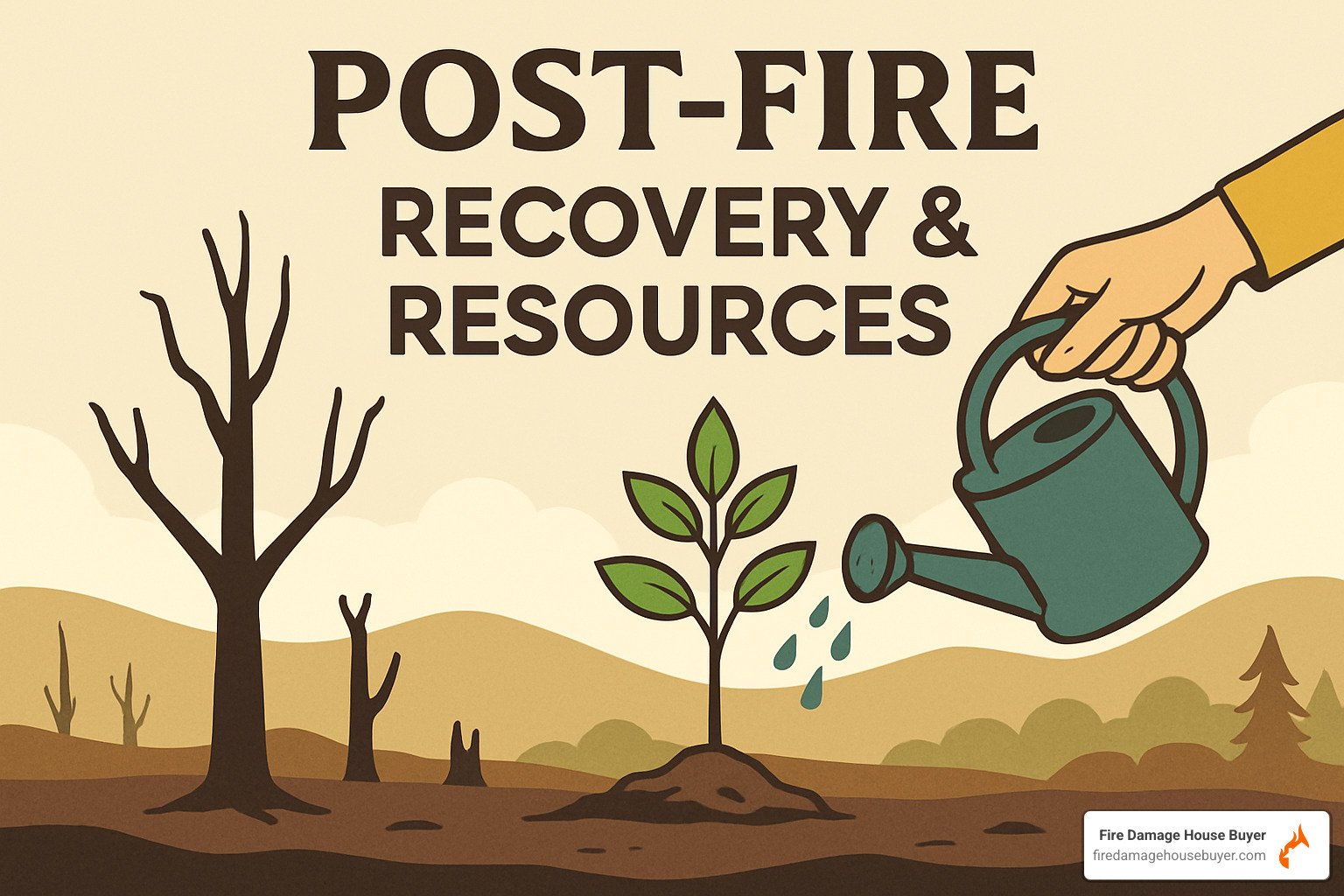
I’ve walked alongside hundreds of fire survivors through their recovery journeys, and I’ve seen how understanding available resources makes all the difference. Let’s explore the lifelines that can help you stay afloat.
When Maria lost her California home to wildfire last year, she told me, “I had no idea where to turn. The paperwork alone was overwhelming.” But within weeks, she had secured temporary housing through FEMA and was on her way to recovery. Your path can be smoother with the right guidance.
FEMA offers two primary programs that have helped countless fire survivors:
Individual Assistance (IA) provides direct financial help for immediate needs. This isn’t just about housing—it covers essential personal property replacement, medical expenses from the disaster, and even funeral costs if you’ve suffered the unimaginable loss of a loved one.
Other Needs Assistance (ONA) fills the gaps that other programs miss. Think of everyday necessities: clothing for work, school supplies for your kids, tools you need for your job, and unexpected medical costs related to the disaster.
“FEMA assistance won’t make you whole again,” Maria Gonzalez, a disaster recovery specialist once told me, “but it’s like a life raft when you’re drowning in expenses.” That’s why savvy survivors pursue multiple assistance programs simultaneously.
Opening FEMA & HMGP Dollars
The Hazard Mitigation Grant Program (HMGP) might sound like boring government jargon, but it translates to real dollars for recovery. Here’s the simple breakdown: if you qualify, you could receive $5,250 per acre for post-wildfire projects.
What makes this program special is its streamlined approach. If your state, tribe, or territory received a Fire Management Assistance Grant declaration after October 5, 2018, you have a 12-month window following a presidential disaster declaration to apply.
Thomas Lee, a mitigation specialist I’ve worked with on several recovery projects, explains it best: “This program cuts through the usual red tape. Instead of complicated benefit calculations, they use a standard per-acre figure, which means money reaches communities faster.”
The math is refreshingly simple: multiply your project’s acreage by $5,250. A 10-acre soil stabilization effort could bring in $52,500 to help restore your land. Check out the National Interagency Fire Center BAER webpage for more details, or go directly to FEMA’s Hazard Mitigation program webpage to learn how to apply.
Navigating Insurance & No-Insurance Scenarios
The moment you’re safe after a fire, your insurance company should be one of your first calls—ideally within 24 hours. Most homeowners policies include several types of coverage that kick in after a fire: dwelling coverage to repair your home, personal property coverage for your belongings, Additional Living Expenses for temporary housing, and liability protection if the fire affected neighboring properties.
“Always ask for an advance on your ALE coverage,” advises Rachel Kim, an insurance expert who’s helped hundreds of fire survivors. “This can put money in your pocket within days for hotel stays and meals while your larger claim is being processed.”
Don’t have insurance? You’re not alone, and you’re not without options:
The American Red Cross and Salvation Army provide immediate emergency assistance regardless of your insurance status. FEMA Individual Assistance becomes available in federally declared disaster areas. Even the Small Business Administration offers disaster loans to homeowners and renters—not just businesses as the name might suggest.
Local disaster relief organizations, religious groups, and community fundraisers often spring up after major fires. I’ve even seen neighbors rally around each other through crowdfunding platforms to help the uninsured get back on their feet.
Elena Vasquez, a social worker who specializes in disaster recovery, shared something powerful with me: “The families who recover best, insured or not, are the ones who stay organized and persistent. Keep good records, follow up regularly, and don’t be afraid to ask for help.”
Post-Fire Recovery & Resources aren’t just about rebuilding structures—they’re about rebuilding lives. Sometimes the best path forward isn’t the one you originally planned. If you’re considering whether to rebuild or sell your fire-damaged house, know that options like Fire Damage House Buyer exist to provide a faster resolution through as-is, cash purchases when traditional recovery paths feel too overwhelming.
Cleanup, Repairs & Landscape Rehabilitation
Once safety assessments are complete and financial resources secured, the focus shifts to cleanup and rehabilitation. This phase typically begins 2-4 weeks after the fire and can continue for months or even years.
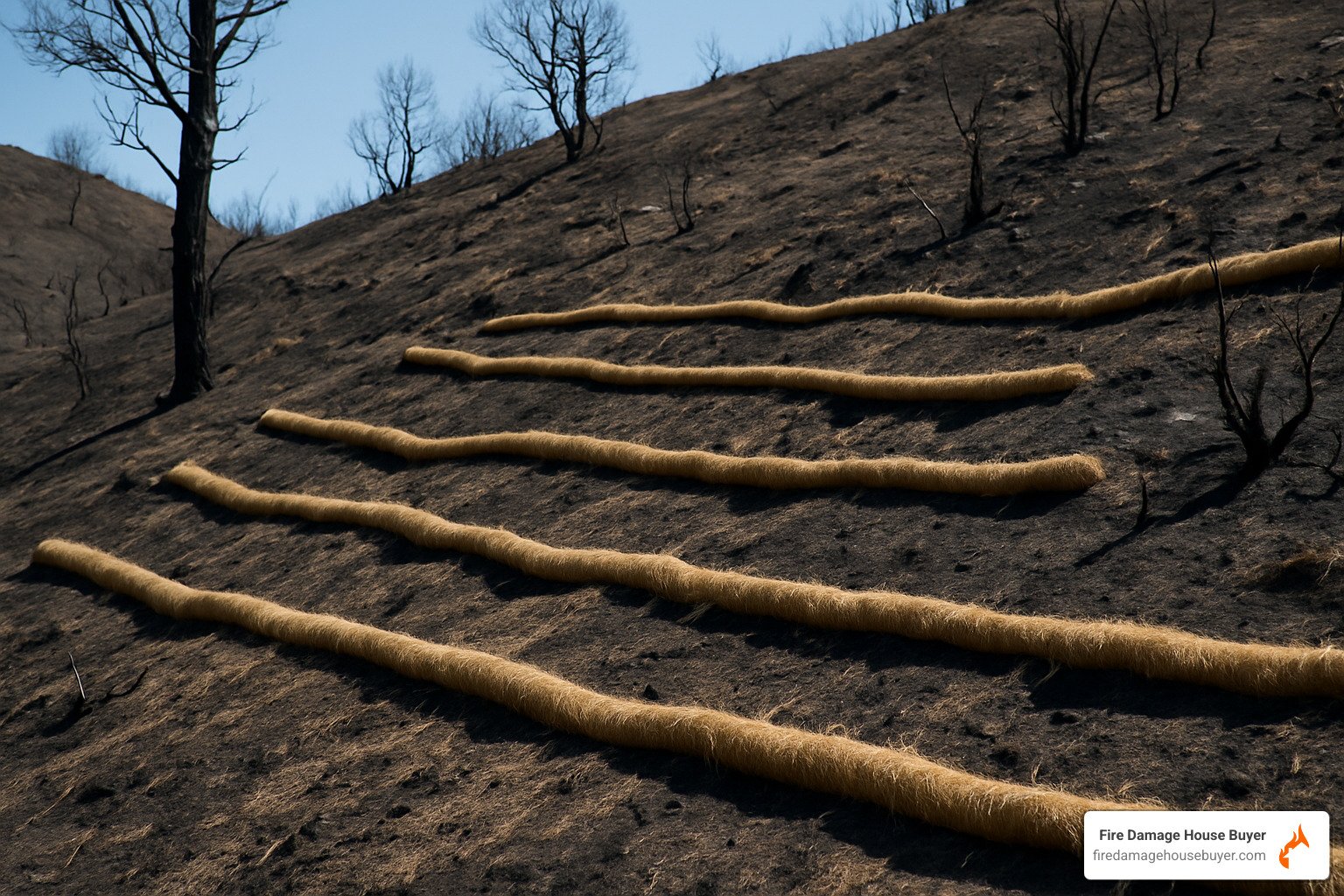
The morning after a wildfire feels like standing on another planet—ash underfoot, the smell of smoke still hanging in the air, and a landscape transformed overnight. It’s overwhelming, but you’re not alone in facing this challenge.
The Burned Area Emergency Response (BAER) program typically completes assessments within 7-14 days after a wildfire, focusing on the most severely burned areas to prevent further damage. Without quick intervention, a single heavy rainfall can trigger devastating mudslides and contaminate water supplies for months.
“We prioritize emergency stabilization before the first major storms hit,” explains BAER team leader Dr. Marcus Johnson. “Most people don’t realize that post-fire flooding is 3-5 times more likely in burned areas due to vegetation loss and increased soil erosion.”
Think of your landscape as a patient in recovery—it needs immediate first aid, then ongoing care. Erosion control comes first, with straw wattles and fiber rolls acting like bandages to slow water flow across your property. A layer of mulch protects exposed soil like a protective dressing, while seeding with quick-growing native species helps jumpstart nature’s healing process.
Flood prevention measures are equally crucial. Simple diversion structures can channel water away from your home, while sediment basins capture debris before it can cause damage downstream. Many communities also install early warning systems for flash floods—worth paying attention to for at least 3-5 years post-fire.
Don’t forget about invasive species management. Nature abhors a vacuum, and opportunistic weeds often try to colonize burned areas before native plants can recover. Early detection and rapid response treatments, including targeted herbicide application where necessary, can protect your investment in native plant restoration.
“The actions—or inaction—taken in the months following a fire can have long-lasting impacts on recovery,” notes forest ecologist Dr. Sarah Chen. “Natural regeneration is powerful, but human intervention can significantly accelerate the healing process.”
Safe DIY vs. Hire-Out Tasks
I remember meeting Maria, whose home survived a California wildfire with moderate smoke damage. “I thought I could handle everything myself,” she told me. “But I ended up making some of the damage worse by using the wrong cleaning products on our hardwood floors.”
Maria’s experience is common. While some cleanup tasks can be safely tackled by homeowners, others require professional expertise. Documentation is always safe to DIY—take photos of everything before you touch it. Removing non-hazardous debris and cleaning hard surfaces with simple soap and water is generally fine too, as is airing out the property and setting up fans and dehumidifiers.
But when it comes to structural repairs, electrical system restoration, or HVAC system cleaning, it’s time to call in the pros. The same goes for serious smoke damage remediation, asbestos or lead containment, and water damage in walls and insulation. These require specialized training and equipment most homeowners simply don’t have.
“Always look for restoration firms certified by the Institute of Inspection, Cleaning and Restoration Certification (IICRC),” recommends restoration contractor Michael Torres. “These professionals have specialized training in fire and smoke damage remediation techniques that DIY approaches simply can’t match.”
Here’s a tip many people don’t know: don’t try to wash smoke-damaged clothing or furniture at home. Home washing can actually set stains permanently. Professional cleaning services have specialized equipment to remove soot and smoke without damaging fabrics.
For more information about navigating cleanup decisions, check out our guide on Legal & Financial Considerations After Fire.
Environmental Recovery & Flood Protection
The danger doesn’t end when the flames are extinguished. In fact, for many properties, the post-fire flooding risk can remain liftd for 3-5 years until vegetation fully recovers.
“Many homeowners don’t realize that their property remains at risk long after the flames are extinguished,” explains hydrologist Jennifer Wu. “I’ve seen homes that survived the fire only to be destroyed by mudslides months later.”
Post-Fire Recovery & Resources for flood protection are most effective when implemented before the first significant rainfall. Silt fences trap sediment while allowing water to filter through, while sandbags direct water flow away from vulnerable areas. Straw bale barriers work wonders to slow water velocity and capture debris, giving your reseeding efforts time to establish vegetation that will eventually stabilize the soil naturally.
For properties in steep terrain, don’t skip getting a professional assessment by a geologist or soil conservation specialist. They can identify high-risk areas and design appropriate mitigation measures specific to your property’s needs.
The recovery journey is different for every family, but there’s something powerfully healing about planting new seeds in burned ground. As you watch those first green shoots emerge, landscapes, like people, can be remarkably resilient when given the right support at the right time.
For a striking demonstration of why these preventive measures matter, check out this eye-opening flash flooding video showing how quickly conditions can change after a fire.
Building Resilience: Post-Fire Recovery & Resources for the Future
Recovery isn’t just about putting the pieces back together—it’s about building something stronger than before. When the ashes settle, you have a rare opportunity to reimagine your home and community with resilience at its core.
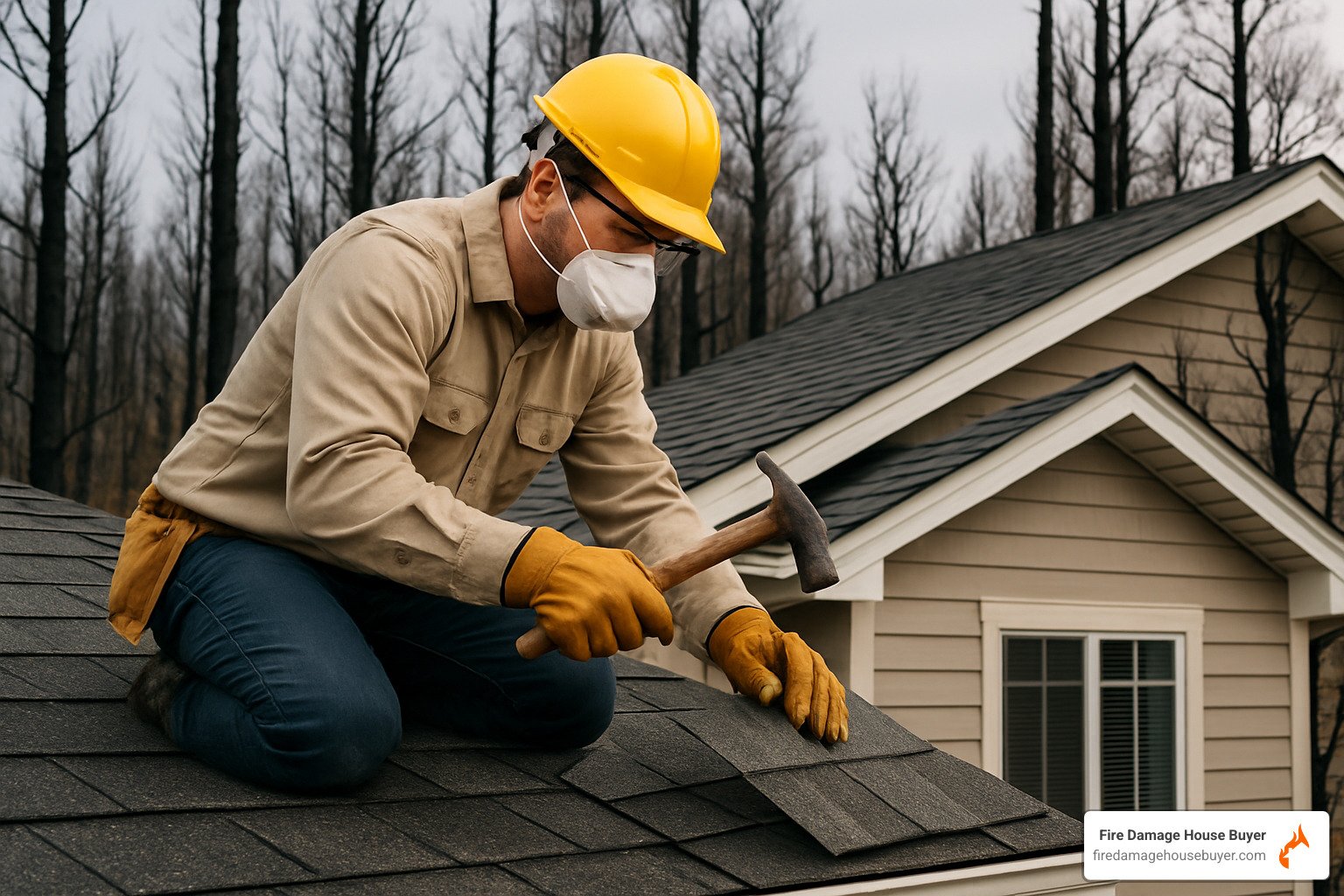
“A wildfire is devastating, but it also creates a blank canvas for implementing the latest fire-resistant building techniques,” says Carlos Mendez, who’s helped hundreds of families rebuild after fires. “The homes that survive future fires are the ones rebuilt with intentional resilience in mind.”
I’ve seen this change firsthand—families who, despite their heartbreak, found the courage to not just rebuild, but rebuild smarter. They created defensible space around their new homes by removing dead vegetation, properly spacing trees and shrubs, and choosing fire-resistant landscaping that’s both beautiful and strategic.
Smart rebuilding isn’t just about the landscape, though. The most resilient homes incorporate fire-resistant construction from the ground up. This means choosing Class A fire-rated roofing materials (like the homeowner in our photo), installing ember-resistant vents, using non-combustible siding, and selecting multi-pane tempered glass windows. Even seemingly small details like enclosing decks and porches can make a tremendous difference when embers are flying.
Community preparedness takes this individual resilience to the next level. “The most resilient communities approach wildfire as a ‘when’ not ‘if’ scenario,” explains Lisa Ramirez, who coordinates Fire Adapted Communities programs. “They integrate mitigation into everyday decisions about home maintenance, landscaping, and community planning.”
Turning Recovery Into Mitigation
The silver lining of disaster? Access to resources that might otherwise be unavailable. During recovery, special funding streams open up specifically designed to help you build back better.
FEMA’s Hazard Mitigation Grant Program (HMGP) provides substantial funding for projects that reduce future disaster risks—often covering up to 75% of approved project costs. Similarly, HUD’s Community Development Block Grant Disaster Recovery (CDBG-DR) can help finance rebuilding with improved resilience measures.
Don’t overlook potential tax incentives, either. Several states offer tax deductions or credits for implementing wildfire mitigation measures. And here’s a practical tip that can save you money year after year: many insurance companies provide premium reductions for homes with documented wildfire resilience features. Be sure to ask your agent about available discounts.
“Recovery isn’t just about restoring what was lost—it’s about creating something better,” urban planner Miguel Santos told me recently. “Communities that accept this mindset not only recover more completely but become models for others to follow.”
Want to assess where your community stands? The Fire Adapted Communities Self-Assessment Tool provides a structured way to evaluate your current preparedness level and identify priority actions for improvement.
Prepare Financially & Emotionally
True resilience goes beyond brick and mortar—it includes preparing your wallet and your heart for whatever comes next.
Financial resilience starts with maintaining adequate insurance coverage and reviewing it annually. Many fire survivors I’ve worked with wish they’d created a more detailed home inventory before disaster struck. Take photos of everything, save receipts for major purchases, and store digital copies in secure cloud storage. And while it may seem obvious, building an emergency fund covering 3-6 months of expenses provides critical breathing room during recovery.
The emotional journey after a fire deserves just as much attention. “The emotional impact of losing your home can be as devastating as the physical loss,” explains trauma counselor Dr. Rebecca Chen. “Many survivors describe feeling a profound sense of grief not just for possessions lost, but for their sense of safety and security.”
If you’re struggling, please know you’re not alone. Connect with support groups of fellow survivors who truly understand what you’re going through. Consider professional counseling to process trauma—it’s a sign of strength, not weakness. And give yourself permission to establish new routines and celebrations that mark your progress, however small.
Resources like the Disaster Distress Helpline (1-800-985-5990) provide 24/7 crisis counseling for anyone experiencing emotional distress related to disasters. There’s no shame in seeking support after a house fire—in fact, it’s one of the most important steps in true Post-Fire Recovery & Resources utilization.
Resilience isn’t about bouncing back to exactly what was before. It’s about growing through adversity and creating something stronger, safer, and more prepared for whatever the future holds.
Frequently Asked Questions about Post-Fire Recovery
How long does full recovery usually take?
The journey back to normalcy after a fire varies tremendously from family to family. While some homeowners might be back in their rebuilt homes within 6 months, others face a much longer road.
Maria Gonzalez, who has guided hundreds of families through recovery as a coordinator, puts it plainly: “For most families, the journey from fire to full recovery takes between 8-18 months. However, I’ve worked with cases ranging from 6 months to over 3 years.”
Your timeline will largely depend on several key factors:
Your insurance coverage (or lack thereof), the extent of damage to your property, available contractors in your area (especially after widespread disasters), local permitting processes, and your own decision-making timeline all impact how quickly you can rebuild.
Most families can expect insurance claims to resolve within 30-90 days, debris removal to take 2-4 weeks, permit acquisition another 2-6 weeks, and the actual rebuilding process spanning 4-8 months. What surprises many homeowners is that landscape recovery takes significantly longer – typically 2-5 years before the natural environment fully rebounds.
Something rarely discussed but universally experienced: emotional recovery often continues long after your home is rebuilt. Many survivors find the first anniversary of the fire particularly challenging as it brings back powerful memories and emotions.
What are the biggest hidden hazards after wildfire?
The obvious dangers after a fire – collapsed roofs, charred walls, downed power lines – aren’t usually what cause injuries during recovery. It’s the hazards you can’t easily see that pose the greatest risks.
Safety inspector James Rodriguez, who has evaluated hundreds of fire-damaged properties, warns: “The most dangerous aspect of these hidden hazards is that they’re easy to overlook in the rush to rebuild. Taking time for thorough professional assessments saves lives.”
Be particularly vigilant about these five hidden dangers:
Compromised foundations can lurk beneath seemingly intact structures. Extreme heat can crack concrete and weaken structural supports even when damage isn’t readily visible to the untrained eye.
Toxic residues form when household chemicals, building materials, and even natural materials create dangerous compounds during combustion. These can remain long after visible flames are extinguished.
Water damage often extends far beyond the fire damage due to firefighting efforts. This hidden moisture can lead to dangerous mold growth within just 48-72 hours, creating health hazards.
Damaged trees might appear stable but have compromised root systems or internal charring that makes them fall hazards, especially during winds or storms in the months following a fire.
Contaminated water systems present another invisible danger. Plastic pipes can absorb chemicals from smoke that later leach into drinking water, requiring thorough testing before use.
Which documents matter most for aid and insurance claims?
Having the right paperwork ready can mean the difference between a smooth recovery process and months of frustrating delays. Disaster recovery specialist Elena Vasquez offers this practical tip: “Create a recovery binder with physical copies and a digital backup of all documents. This single organizational step can save countless hours of frustration during the claims process.”
For insurance claims, prioritize gathering your insurance policy and contact information, a pre-fire home inventory (if you have one), proof of ownership or residence, detailed photos and videos of all damage, receipts for any emergency expenses, and repair estimates from licensed contractors.
When applying for government assistance programs like FEMA aid, you’ll need photo identification, Social Security numbers for all household members, clear proof of occupancy or ownership, recent income information, banking details for direct deposits, and a thorough description of your disaster-caused losses.
Different programs may require different documentation, so it’s best to gather everything you possibly can. If certain documents were lost in the fire, contact issuing agencies immediately to begin the replacement process. Many government agencies have special procedures to expedite document replacement for disaster survivors.
The paperwork process can feel overwhelming when you’re already dealing with so much, but staying organized from the beginning will significantly reduce your stress in the long run and help ensure you receive all the assistance you’re entitled to during your Post-Fire Recovery & Resources journey.
Conclusion
When the smoke clears and you stand looking at what remains, Post-Fire Recovery & Resources aren’t just items on a checklist—they’re stepping stones on your path forward. This journey from devastation to renewal isn’t always straightforward, but with each step, you’re building not just a house, but a more resilient future.
I’ve walked alongside hundreds of families through this process, and I’ve seen how overwhelming it can feel. The good news? You don’t have to figure it all out alone.

As you steer your recovery, keep these guiding principles close to heart:
Safety comes before speed. It’s natural to want your life back quickly, but rushing can lead to overlooked hazards. That structural engineer’s assessment might delay your timeline by a week, but it could save your life.
Your camera is as valuable as your hammer. Those photos and videos you took right after the fire? They’re gold when dealing with insurance adjusters and assistance programs. Keep documenting everything—from conversations with contractors to receipts for that emergency hotel stay.
Cast a wide net for help. From FEMA grants to local church donations, recovery often comes through piecing together multiple sources of support. Don’t hesitate to apply for everything you might qualify for—you can always decline what you don’t need.
Today’s decisions shape tomorrow’s safety. When rebuilding, those fire-resistant materials and defensible space plans aren’t just good ideas—they’re investments in never having to go through this again.
Your emotional wellbeing matters as much as your roof. I’ve seen too many people power through the physical recovery while neglecting their mental health. That support group might feel unnecessary now, but connecting with others who truly understand can be profoundly healing.
For some homeowners, the thought of rebuilding feels like climbing a mountain that’s just too steep. If you’re wondering if there’s another path forward, we understand. At Fire Damage House Buyer, we offer an alternative for those who need to close this chapter more quickly:
- We purchase fire-damaged properties in any condition across all 50 states
- Our cash offers mean no waiting for financing approvals
- You won’t pay commissions or closing costs
- We handle the cleanup, so you can truly move on
- Most importantly, you can close on your timeline—whether that’s next week or next month
Whether you choose to rebuild your home or start fresh somewhere else, recovery isn’t just about replacing what was lost. It’s about creating something that honors what was while embracing what can be—a home and community that’s stronger, safer, and ready for whatever comes next.
Looking for more guidance? Contact our team directly for personalized support through each step of your recovery journey.
